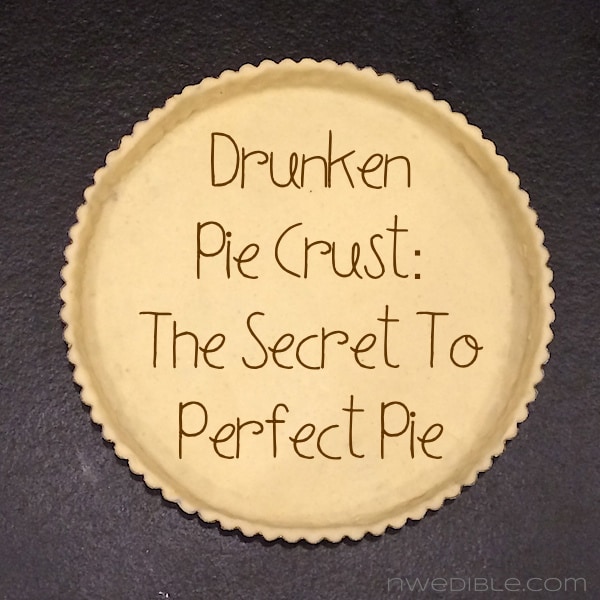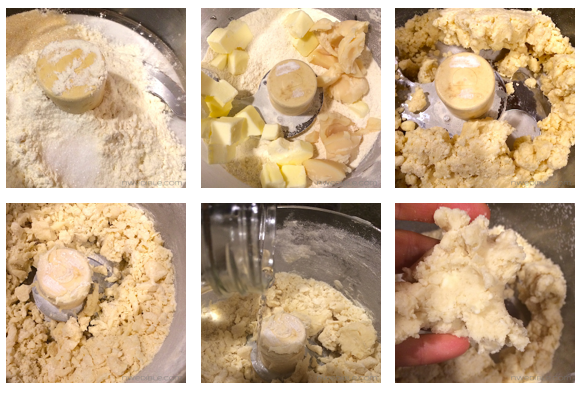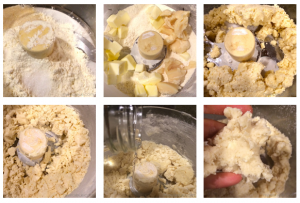Other dishes are quintessential on the Thanksgiving table, sure: turkey, stuffing, mashed potatoes. I consider Brussels sprouts essential, and some kind of cranberry preserve that has never seen a can must grace the table, too.
But pie – oh boy, that’s where the buck stops, isn’t it? Pumpkin pie is a classic, but apple and pecan have their ardent fans. To me, it’s all good – any good pie is good pie. And so the ideal filling for a Thanksgiving pie isn’t a hill I’m willing to die on, but I will shout loudly from the mountaintop about crust.
Cook’s Illustrated published a recipe for pie crust some years back that made the entire food-nerd world giggle with molecular excitement. They had discovered, you see, that replacing some of the water in a traditional pie crust with vodka led to pie crust perfection.
Pie makers have a love-hate relationship with water. Some H20 is necessary, of course, to keep the dough together. But flour + water = gluten, and gluten makes pastry tough. Tough pie crust is not good pie crust. Vodka in place of some of the water allows the necessary binding, but doesn’t activate gluten. Result: perfect flakey-yet-tender pie crust.
Cook’s Illustrated explains the science in their excellent food-nerd cookbook, The Science of Good Cooking, which contains this method for pie-crust perfection: “Gluten forms readily in water…. But gluten won’t form in alcohol. The ethyl alcohol in vodka and other liquors does not attach itself in the same way as water. Because of this, it does not hydrate the proteins, and therefore does not aid in gluten formation.”
Vodka is the spirit of choice because it’s neutral – in the oven the alcohol just evaporates away leaving, well, nothing. Cook’s Illustrated says that even more aggressive spirits do not add a particularly distinct flavor after baking. Still, unless I wanted to bring another flavor to the pie party, I would stick to vodka. And although I haven’t tried it, I think a bourbon crust for pumpkin pie would certainly not suck. If you do substitute another tipple, keep it 80 proof (40% alcohol by volume) so as to not throw off the alcohol-to-water ratio of your pie crust.
Although the vodka does add a substantial measure of insurance to this crust, all the standard pie-crust making rules still apply: keep everything as cold as possible, bring the crust together in a food processor, and let the dough rest (chilled, natch) before attempting to roll it out.
If you are in charge of pie this Thanksgiving, try this crust. I think you’ll like how it performs.
Drunken Pie Crust

Drunken Pie Crust
Makes 1, 9-inch single pie shell. Recipe can be doubled for a double-crust pie. Recipe adapted from the Foolproof Pie Crust originally published by Cook's Illustrated.
Ingredients
- 1 ¼ cup all-purpose flour, divided, plus more for rolling out crust
- 1 tablespoon sugar
- ½ teaspoon salt
- 6 tablespoons unsalted butter, cut into medium dice and chilled
- 4 tablespoons lard, cut into medium dice and chilled (vegetable shortening may be substituted)
- 2 tablespoons vodka, chilled
- 2 tablespoons ice water
Instructions
- In the bowl of a food processor fitted with the metal blade, pulse together ¾ cup of the flour, all of the sugar and all of the salt until combined, about five seconds.
- Add butter and lard to the food processor and process until the fat is incorporated and the mixture is fairly smooth, about 15 seconds.
- Scrape bowl and add remaining ½ cup flour to the food processor. Pulse 4-6 times, just until mixture is crumbly.
- Add vodka and ice water to the food processor. Pulse 3 to 5 times, until liquids are just incorporated.
- Flip dough from food processor bowl onto a sheet of plastic wrap. Pat dough into a smooth disk and wrap well.
- Transfer dough to refrigerator and chill for at least one hour and up to two days. Dough can also be frozen at this point for up to one month.
- To roll dough, remove from refrigerator and let sit until softened slightly, about ten minutes.
- Roll dough into a 12” inch circle on a floured surface. I prefer to roll pie crusts on a silicon baking sheet or parchment paper because this slightly lessons the additional flour needed. However, this dough is soft, and you should expect to use about ¼ cup additional flour to keep it from sticking while you roll.
- Use pie crust in any standard pie recipe. Blind bake or fill as pie recipe instructs.
Step-by-Step Visual Guide To Perfect Pie Crust

Dry ingredients (only 3/4 cup flour) get pulsed to blend in the food processor (top right) then the two fats – butter and lard – are added (top center). Substitute vegetable shortening or coconut oil if you must. Pulse until flour-fat mixture is fairly smooth (top -right), then add in the remaining flour (not shown) and pulse until mixture is crumbly (bottom left). Add vodka and ice water (bottom-center) and pulse just to combine (bottom-right).

Turn dough out onto a sheet of plastic wrap (top right), smooth into a disk and wrap well (top center). After chilling (top-right), roll dough out on a floured surface – I prefer to roll onto a Sillpat or piece of parchment (bottom-left). To transfer dough to pie or tart pan, I like to fold dough in half (bottom-center), gently lift it into the pan and unfold (bottom-right).
That’s it! Super easy to work with pie crust that gives great results on the plate. That’s something to be thankful for!
What’s your Thanksgiving pie choice? I’m not going to throw down or anything, but I am a classic pumpkin pie girl, myself.
Related Stuff…
(These are affiliate links. Purchases made through these links cost you nothing extra but allow me to nerd out about using vodka as a cooking ingredient more often. Full financial disclosure here. Thanks for your support, guys.)
Cuisinart Food Processors. I have two. I used them both today, for real.
Silicon Baking Mats. Naked sheetpans get super bashful. Cover them up with silicone baking mats, the reusable version of parchment.
Silicon Rolling Pin. One Christmas about five years ago I worked a seasonal shift at Williams-Sonoma and funneled my entire paycheck back into quite a few cool kitchen gadgets at the employee discount rate. Hands down the best thing I bought was a silicon rolling pin. I love mine. It makes cookies, pie crust and more so much easier.
Cook’s Illustrated Library. I have four of the Cook’s Illustrated Cookbooks and they are all really that good. I find the entire Cook’s Illustrated schtick kinda annoying, but their recipes are always totally solid and trustworthy and I love learning the science behind why their recipes work.
21
I have been using this recipe for several years now with much success. As I have several family members who are vegetarians, I skip the lard and use all butter. The crust is still flakey and oh my the flavor is great.
I mix the water and the vodka together before adding to the dry ingredients. Another variation that I use for pie crust and cookie dough is to roll them out between layers of plastic wrap. I just re-use the plastic that I chilled the dough in. This eliminates adding more flour — most of the time.
Here’s another ‘science’ take on piecrust, from the person who helped develop the CI vodka recipe… and all butter 🙂 Same basic process, but emphasis on ‘folding’ dough into ball w/ spatula. I think incorporating the vodka into the water with this recipe might be the ….. ‘best’ ??
BTW if you like manually ‘cutting’ the fat in, try freezing the butter, then grating it right in the bowl of flour, rolling the butter cube in the flour, coating it, as you go… helps with the melting factor.
I do the grating butter method too plus I use a fork to mix . Ceramic bowl ,wooden rolling pin and wooden table – Plastic free kitchen is my goal
David
Oops, forgot the link…
http://www.seriouseats.com/recipes/2011/07/easy-pie-dough-recipe.html
My wife makes amazing pie crust but, since I do most of the cooking around here, I tend to stick with crumb-crusts if I can possibly manage it. I find that pumpkin pie done with a crumb-crust of chocoalte cookies and/or pecan flour is mind-bogglingly amazing, fwiw. Still: Good to know about the booze trick, though. I may have to try that (I do have a tiny bit of vodka floating around, so…). Thanks. 🙂
I am massively allergic to vodka, so I’ve always avoided the idea of it in pie crusts. Thank you for suggesting using a different booze!! I don’t know why my brain never made that leap before, and now I can’t wait to try bourbon for my pumpkin pie. I actually love the pumpkin pie filling so much that I don’t even care if it’s in a pie shell, but everyone else expects pie at Thanksgiving.
I freeze/grate the butter, and it works really well. I also measure all the dry ingredients out into a bowl and put the bowl in the freezer for a little while before mixing (shortening goes on a small plate in pre-scooped chunks); works especially well with stainless steel, since the idea is to chill all the ingredients to reduce melting. I’m not sure if it actually helps any when the frozen butter hits chilled flour instead of room-temperature flour, but it makes me feel fancy 😀
I also do not use a food processor because I don’t have one. First, I use two butter knives in criss-cross motion to chop up the shortening chunks, then I use my grandmother’s pastry blender to get the mixture down to small pea-sized. Then I slowly add ice water, gently mixing and pressing and folding with a spatula. My pie crust always gets rave reviews! But I am so trying this vodka thing, never heard of it before.
(Word to the wise on pastry blenders, though; the ones made out of wire get bent and clogged and are just generally less useful. My grandmother’s is one solid piece of metal that’s easy to unclog and never changes shape. It’s awesome.)
Incidentally, Erika, I’ve been devouring your blog for the last few weeks, but have never had anything to contribute until now. So thanks for a piecrust post! And to answer the question, I make a pecan pie that my dad swears is just like his grandmother (my great-grandmother) used to make, which I consider one of the highest compliments I’ve ever received.
Live this recipe and can’t wait to give it a try- it was my New Years Resolution this year to learn to make pastry and pasta from scratch! However is it possible to get the butter/lard amounts by weight? Not sure how to get accurate tablespoons from a brick! Thanks so much
Of course. I prefer weight measures, anyway. Butter and lard are both 1/2 oz. per tablespoon, or 2 tbsp to the ounce. So, for this recipe, use 3 oz. butter and 2 oz. lard.
So interesting — per Julia Child, the reason for the resting is to allow the gluten to form, and that without it you cannot get a flaky crust. Since I do a fair amount of gluten-free cooking, I understand completely what happens when you don’t have gluten — and, trust me, it isn’t a flaky crust. So, I’m left wondering — who is right? CI or JC?
Or does it matter, if the result is perfection –must we always know the reason? FWIW: JC’s crust recipe in “The Way to Cook” has always worked beautifully for me…
I skip the gluten altogether, I have a recipe that uses rice flour, sorghum flour, and tapioca starch with a little xanthan gum for sticking power, and have tender flaky pie crust every time; I don’t have to fight dough elasticity either. It’s delicate when raw, but once you get it in the pie plate… even my crust hating husband will eat it and he isn’t gluten free like I have to be. I always had trouble back before my Celiac dx using wheat flours, I either ended up with hard or chewy, even when I got it flaky it was never tender. After creating my current crust recipe, even if I could eat gluten again I’d never go back. You just have to find the right combination and technique. Keep trying… perfect GF pie crust is totally possible.
Rachel, would you be willing to share your gluten free recipe? My sister-in-law has celiacs and I would love to be able to bake her a pie.
The flaky comes from the fat, (not the gluten) and you chill the dough so the fat is very cold when it goes in the oven. And you can make a flaky crust without alcohol, provided you don’t overwork the dough. Over working activates the gluten. Work you pie dough quickly, fill it quickly and get that thing in the oven fast and you will have a tender flaky crust.
I tried this yesterday, used chilled tequila (no vodka in the house) and made two batches -one pumpkin pie, one chocolate mousse pie. It was the best crust EVER! No tequila flavoe. My family raved about it. I think it is the first time everyone ate all of the crust. I used Spectrum Organic shortening instead of lard. Thank you!!
Just tried this for the first time. Mmmmmmm. It kicks some serious ass. Thanks for posting!
Your detailed entries, recipes and pictures are so considerate of the reader. It is truly a labor of lover here. I am interested in the new-age “housewife” genre, always wanted to ‘be’ one myself, and have attempted it on occasion, however, it is difficult to pull off when society privileges the “professional” whatever, and when ones “career” is perceived as some kind of “track” that, if one wants to meander, threatens to derail one.
Would you adopt me?